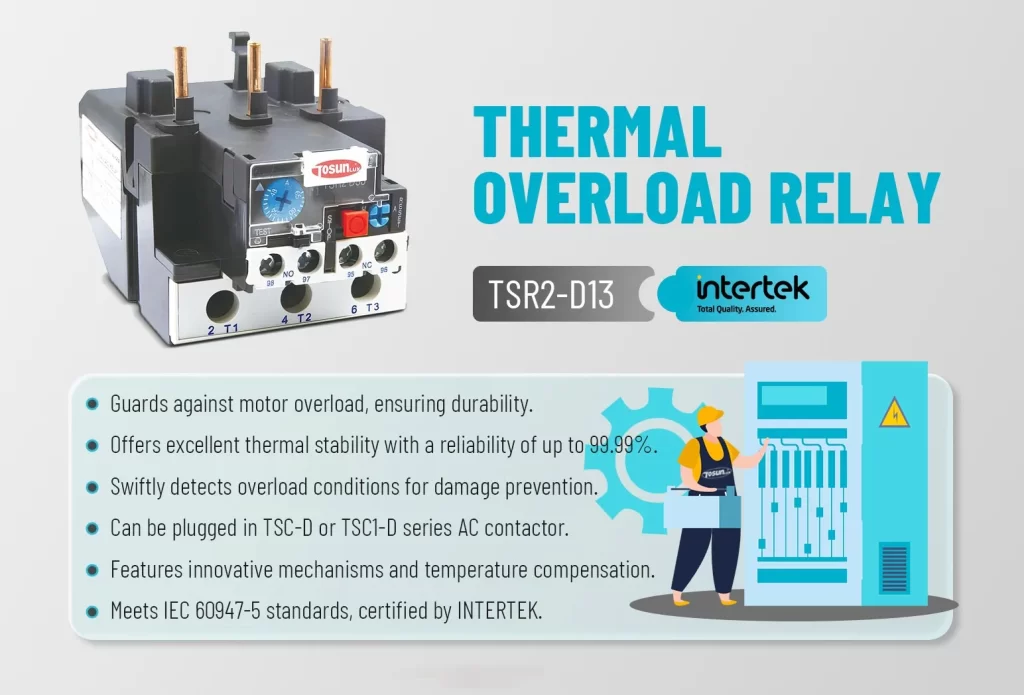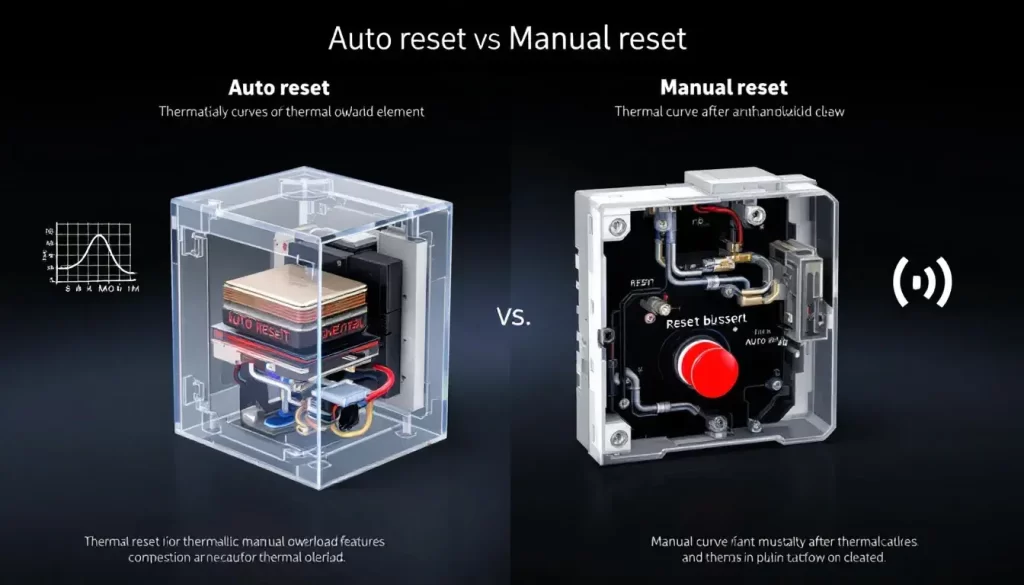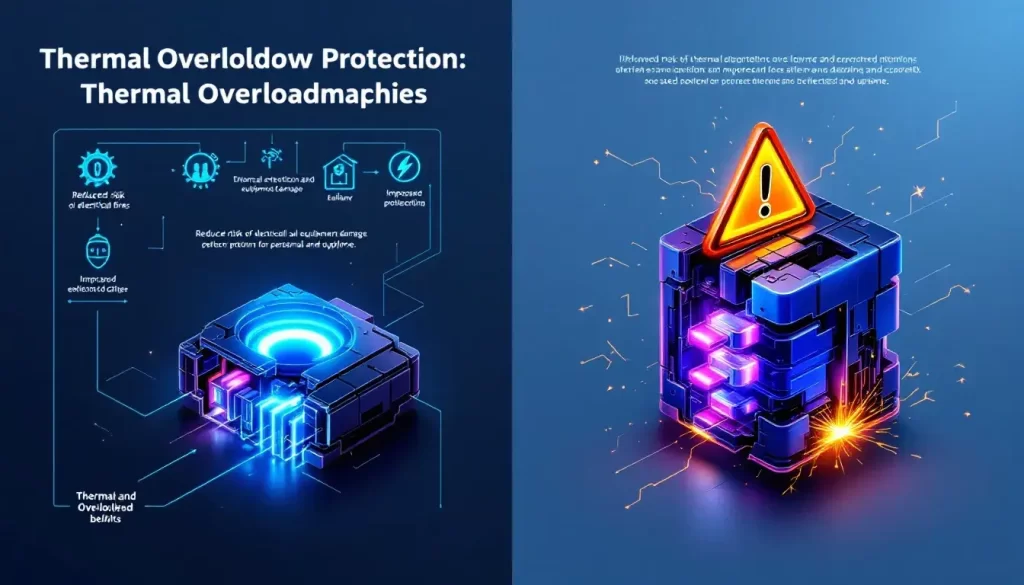Keuntungan Proteksi Relai Termal
Daftar isi
BeralihProteksi relai termal sangat penting untuk melindungi sirkuit listrik dari panas berlebih dan kerusakan. Proteksi ini bekerja dengan memantau panas dalam sirkuit dan memutus pasokan daya jika suhu menjadi terlalu tinggi, mencegah kegagalan dan memperpanjang masa pakai peralatan. Dalam artikel ini, kita akan membahas apa itu proteksi relai termal, cara kerjanya, serta manfaat dan kekurangannya.
Apa itu Proteksi Relai Termal?

Perlindungan relai termal mencegah panas berlebih dan hubungan arus pendek dalam rangkaian listrik kontrol manual. Relai kelebihan beban termal memantau panas dalam rangkaian listrik. Jika motor menarik arus yang berlebihan, yang menyebabkan potensi kerusakan, relai akan aktif untuk memutus rangkaian dan mencegah kerusakan lebih lanjut.
Relai kelebihan beban termal melindungi motor dari kelebihan beban listrik dengan mendeteksi panas selama pengoperasian. Jika suhu melebihi ambang batas aman, relai kelebihan beban termal akan merespons, dan relai akan trip untuk memutus pasokan daya, mencegah kegagalan motor dan memperpanjang umur peralatan. Memahami cara kerja relai kelebihan beban termal sangat penting untuk efisiensi perlindungan motor.
Misalnya, Relai Beban Lebih Termal Chint mencegah kebakaran dan masalah kelistrikan sekaligus melindungi sistem kabel saat terjadi arus berlebih. Relai ini sangat penting dalam mencegah kerusakan permanen akibat panas berlebih, sehingga sangat diperlukan untuk perlindungan motor, keandalan sistem, dan sebagai perangkat perlindungan beban lebih.
Reset Otomatis vs. Reset Manual pada Relai Beban Lebih Termal

| Fitur | Relai Beban Termal Reset Otomatis | Reset Manual Relai Beban Termal Lebih |
|---|---|---|
| Operasi | Secara otomatis menghidupkan ulang motor setelah pendinginan. | Memerlukan tindakan eksternal untuk menghidupkan kembali motor setelah perjalanan. |
| Keamanan | Dapat menimbulkan risiko akibat penyalaan ulang motor secara tidak sengaja. | Lebih aman karena memastikan penyelidikan dan penyelesaian penyebab kelebihan beban sebelum memulai ulang. |
| Kenyamanan | Bermanfaat untuk operasi berkelanjutan pada instalasi jarak jauh atau tak berawak. | Memberikan keamanan dan kontrol ekstra, karena waktu pendinginan bervariasi berdasarkan kondisi lingkungan. |
| Kesesuaian Aplikasi | Cocok untuk aplikasi di mana memulai ulang segera bukan merupakan masalah keamanan. | Ideal untuk sebagian besar aplikasi yang mengutamakan keselamatan dan masalah mendasar perlu diatasi sebelum memulai ulang. |
| Kondisi Lingkungan | Kontrol yang lebih sedikit atas waktu pendinginan karena restart secara otomatis. | Waktu pendinginan bergantung pada kondisi lingkungan, sehingga memungkinkan proses pendinginan yang lebih terkontrol dan aman. |
Manfaat dan Kekurangan Relai Beban Lebih Termal

Relai beban berlebih termal merupakan alat penting untuk melindungi motor dari panas berlebih dan kerusakan. Relai ini memiliki kelebihan dan kekurangan yang harus Anda ketahui sebelum menggunakannya.
Manfaat
- Perlindungan Motor yang Efektif: Relai beban berlebih termal membantu mencegah kerusakan pada motor dengan menghentikan daya saat arus terlalu banyak. Hal ini menjaga motor agar tidak terlalu panas dan memastikannya bertahan lebih lama.
- Hemat Biaya: Relai ini terjangkau dan memberikan perlindungan yang andal tanpa menguras kantong. Relai ini merupakan pilihan yang baik untuk berbagai aplikasi.
- Mudah untuk Dipasang: Relai beban berlebih termal dapat langsung dipasang, sehingga mudah dipasang. Ini menghemat waktu dan tenaga selama pemasangan.
- Andal dalam Kondisi Sulit:Dibuat agar tahan terhadap lingkungan yang keras, relai ini memastikan kinerja yang dapat diandalkan dalam industri yang membutuhkan keandalan tinggi.
- Respon Akurat: Strip bimetal pada relai ini bereaksi secara tepat terhadap perubahan suhu, memutus daya saat diperlukan untuk melindungi motor.
Kekurangan
- Waktu Respon Lambat: Relai kelebihan beban termal bimetalik mungkin memerlukan waktu lebih lama untuk bereaksi terhadap panas berlebih, yang dapat menjadi masalah dalam situasi kritis yang memerlukan tindakan cepat.
- Tidak Ada Pemutusan Langsung: Mereka tidak dapat mengganggu sirkuit secara langsung. Anda akan memerlukan perangkat tambahan, yang dapat membuat sistem menjadi lebih rumit dan mahal.
- Keausan Mekanik:Sering tersandung dan mengatur ulang dapat merusak menyampaikan dari waktu ke waktu, yang memengaruhi keandalannya.
- Perjalanan Mengganggu:Terkadang, relai ini mungkin trip karena kelebihan beban sementara atau fluktuasi tegangan, yang menyebabkan gangguan yang tidak perlu.
- Model Lama:Beberapa model lama, seperti Solder Pot Thermal Overload Relays, mungkin tidak merespons secepat relay elektronik baru, yang dapat menjadi kerugian dalam lingkungan yang serba cepat.
Memahami manfaat dan kekurangan ini akan membantu Anda membuat keputusan yang tepat tentang penggunaan relai beban berlebih termal dalam sistem kelistrikan Anda. Pengetahuan ini penting untuk memastikan keamanan dan keawetan motor Anda.
Ringkasan
Relai beban berlebih termal sangat penting untuk melindungi sistem kelistrikan dari panas berlebih dan arus berlebih, serta memastikan keamanan dan keandalan motor. Relai ini menawarkan manfaat seperti efektivitas biaya dan pemasangan yang mudah, tetapi memiliki keterbatasan seperti waktu respons yang lambat. Pemilihan antara model pengaturan ulang otomatis dan pengaturan ulang manual bergantung pada kebutuhan keselamatan tertentu.
Memahami faktor-faktor ini sangat penting untuk penggunaan yang optimal. Pastikan umur panjang dan keamanan motor Anda dengan memilih beban termal yang tepat relai untuk aplikasi AndaPertimbangkan untuk meningkatkan ke model terbaru untuk perlindungan dan efisiensi yang lebih baik.
Telp: +86-577-88671000
Surel: ceo@tosun.com
Skype: tosunelektrik
Telepon: +86-139 6881 9286
WhatsApp: +86-139 0587 7291
Alamat: Kamar No.1001 Wenzhou Fortune Center, Station Road, Wenzhou, Tiongkok
PERMINTAAN PENAWARAN
WhatsApp kami
 : +86-139 0587 7291
: +86-139 0587 7291 Bahasa inggris
Bahasa inggris Bahasa Spanyol
Bahasa Spanyol Rusia
Rusia Perancis
Perancis العربية
العربية Portugis Brasil
Portugis Brasil Ukraina
Ukraina Bahasa Turki
Bahasa Turki Bahasa Polandia
Bahasa Polandia Belanda
Belanda Bahasa Italia
Bahasa Italia Bahasa Indonesia
Bahasa Indonesia Bahasa Hindi
Bahasa Hindi اردو
اردو 08:00
08:00 Tambah
Tambah Tidak ada
Tidak ada Mongol
Mongol Bahasa Inggris
Bahasa Inggris Bahasa Inggris Shqip
Bahasa Inggris Shqip Yunani
Yunani


